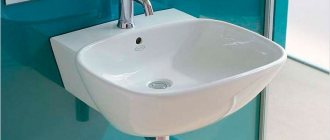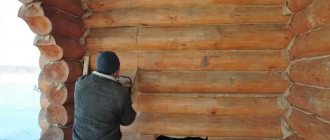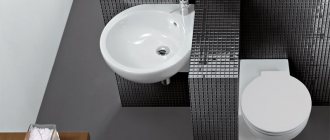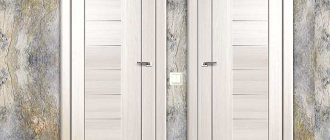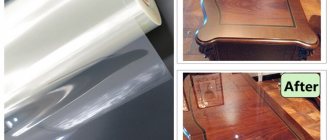Material selection
You can make your own sink from various materials. These include wood, acrylic, stone and concrete. But concrete products remain easy to make. This material is cheap and easy to manage.
Concrete sink
Getting a sink that matches the design is not so easy. After all the work, the concrete sink will not be inferior in appearance and functionality to a marble sculpture.
Features of products made from natural materials
Plumbing fixtures made from natural stone are distinguished by the fact that they are carved from large pieces or combined from several parts. The materials used are soapstone, marble, onyx, basalt, granite, sandstone, travertine and other ornamental minerals that have the necessary strength and can be machined.
Sawing, milling, grinding and polishing are used to give shape.
To reduce the porosity of the outer layer, additional processing is used that does not disrupt the structure of the material and the unique pattern. This provides protection from water penetrating through the pores and household pollutants dissolved in it.
This sink is functional and easy to use. In addition, it will be an excellent indicator of taste and wealth. The aesthetics of the material is expressed not only in the design form of the products, but also in the expressiveness of the pattern and the richness of the color of natural stone.
Some solutions require monotony, others require multicolor or a pronounced pattern of spots, veins, layers and inclusions. Marble, malachite, onyx, jasper have a rich palette; travertine, jade and sandstone provide the most delicate shades.
Onyx sinks are highly polished; plain stones combine perfectly with reliefs. For richly textured pieces, simple shapes and neutral surroundings are preferred. Let's take a closer look at the most popular materials.
Granite
Its relatively low cost makes it the most popular material. Granite comes in different colors. It may be dominated by pink shades, pink-red or gray. Durable, resistant to moisture and chemicals, granite sinks are durable and easy to maintain.
Marble
A product made of material worthy of palace halls will decorate the bathroom. Marble, with its beautiful cool tones, is stunning and brings comfort and harmony to a room.
The material is durable, does not form cracks, does not delaminate, and can withstand severe loads. Its distinctive feature is the complete absence of hygroscopicity; it does not require special care, only standard sanitary actions.
Onyx
The striped fibrous structure of the material looks expensive and luxurious. A variety of shades - from light yellow to dark brown - allows you to create unique designs. Onyx can be completely opaque or translucent with a glass-like shine. Low porosity results in high water repellency.
Basalt
A commonly found rock used in the production of exclusive shells. The products are strong and durable, in black, gray and greenish-black shades. Basalt is heavy and at the same time practical, easily processed stone. Resistant to water and chemicals, absorbs sound.
Travertine
A beautiful, light and dark shade, pliable stone with a patterned texture. Strong, lightweight and durable products of various shapes are made from it. The disadvantage is the porosity of the structure, which requires careful care of the products.
A stone sink will be appropriate in any interior style. The combination of a unique pattern, magical energy and design solutions will create a special world in your bathroom.
Required tools and materials
It is important to use high-quality materials in your work. In this case, attention is paid to the concrete solution. It is advisable to choose a solution with high performance. In addition, a mold for filling is required, but you can make the mold yourself.
To make a sink with your own hands from concrete, you need the following tools to organize the formwork:
- Plastic dowels and screws 8 mm – 30-35 pieces;
- Fiberboard sheet, small trimmings are also suitable;
- A sheet of stainless material, for example tin;
- Sealant, it is better to purchase a plumbing sealant;
- Reinforcement per 100 mm – 8 rods;
- Plastic pipes for part of the drain and under the mixer;
- Polyethylene film;
- Hangers and corners of various shapes;
- Bricks or blocks that will support the weight of the formwork.
In this case, the option of not simply manufacturing the product is considered. It is much easier to make a concrete sink by pouring it with parallel fastening in place.
Before starting work, purchase the required materials. The manufacturing process requires full attention, and being distracted by searching for a screw or other tool can negatively affect the final result of the work.
To prepare a concrete mixture you will need the following materials:
- Sand, pre-sifted, washed, dried. Sand size no more than 2 mm;
- High quality cement;
- The water is warm, without impurities, it is better to take filtered or bottled water;
- For cladding you will need granite or marble chips;
- Fiber fiber, if available, it is advisable to add to eliminate cracking of concrete;
- Plasticizer of any brand, additive for waterproofing.
It is advisable to use concrete grade M400 and higher.
For cladding I use the following materials:
- Tile mosaic tiles;
- Grout on seams with a waterproof effect;
- Mold resistant tile adhesive.
About this video
#Sink_made of_stone with your own hands: #grinding of natural #stone and depth, Day 5 A sink made of stone, or as it is popularly called - a washbasin, a washstand made of natural stone with your own hands - Day 5 of working on a sink was memorable for the process of grinding stone, for the first time I am grinding stone using a diamond discs for grinding natural stones, granite, etc. The fifth day was also memorable for the fact that the depth of the sink that I planned to make from this stone was almost ready, when I planned to make a washbasin from this stone. Also, at 90% of the depth of the sink, an outline began to appear of what exactly the sink would look like inside and what shape it would be. I would like to dwell in more detail on the process of polishing natural stone: to polish the stone you will need a diamond disc for the stone, an attachment for an angle grinder or a drill, as in my case. I chose the Velcro attachment option with removable polishing discs, which will allow me to change sanding attachments as I polish the stone and achieve a smoother surface. I thought that I would put the disc on the grinder, but I didn’t take into account that my grinder has a minimum speed of 12,000 rpm, and the attachment for stone grinding discs with a diameter of 100 mm is designed for 8,500 rpm - the maximum, which of course showed itself after installation and shook grinder, ate held
